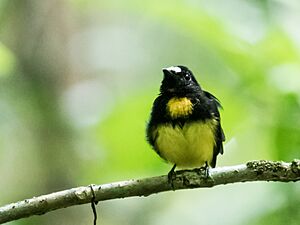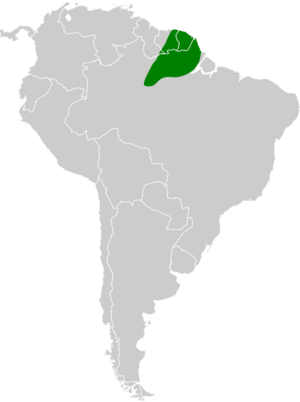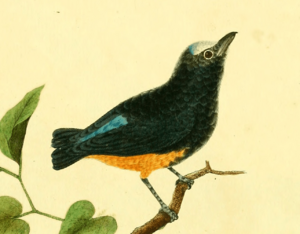White-fronted manakin facts for kids
Quick facts for kids White-fronted manakin |
|
|---|---|
 |
|
| Conservation status | |
| Scientific classification | |
| Genus: |
Lepidothrix
|
| Species: |
serena
|
 |
|
| Synonyms | |
|
Pipra serena Linnaeus, 1766 |
|
The white-fronted manakin (Lepidothrix serena) is a small, colorful bird. It belongs to a group of birds called manakins. You can find it in places like French Guiana, Guyana, Suriname, and parts of northeastern Brazil. It lives in warm, wet forests close to the ground.
Male manakins are mostly black. They have a bright blue patch on their lower back and yellow spots on their belly. A special patch of white feathers sticks out from their forehead. Female manakins are gray and black with a pale yellow belly. They also have a white ring around their eyes. This bird is quite common, and experts say it is not in danger of disappearing.
Contents
Understanding the White-fronted Manakin
In 1760, a French scientist named Mathurin Jacques Brisson wrote about the white-fronted manakin. He saw a bird from French Guiana. Later, in 1766, the famous Swedish scientist Carl Linnaeus gave this bird its official scientific name, Pipra serena. The word serena means "bright" or "fair" in Latin. Today, this bird is placed in the genus Lepidothrix.
What Does the White-fronted Manakin Look Like?
This bird is mostly a deep black color. It gets its name from the bright white feathers on its forehead. These feathers stick out past its beak. Only the male birds have this white patch.
Besides the black body and white forehead, male manakins have other cool colors. There's a narrow patch of light blue feathers on their lower back. They also have bright yellow patches on their chest. Their legs are black, and their eyes are dark.
Female manakins look different from the males. This is called sexual dimorphism. Females are grayish and black. They have a yellow belly and a white ring around their eyes.
Where Do White-fronted Manakins Live?
You can find the white-fronted manakin in the eastern parts of South America. This includes French Guiana, Suriname, and parts of Guyana. It also lives in the northeastern Amazon region of Brazil.
These birds prefer to live in warm, wet lowland forests. Their home range is quite large. In Brazil, they live in the state of Amapá. Their range also extends along the north bank of the Amazon River for a long distance. They do not live south of the Amazon River.
Some groups of these birds are found in the southeast parts of Suriname. In Guyana, they are mostly in the southeast. However, some smaller groups can also be found in the southwest, near the Essequibo River.
Conservation Status of the White-fronted Manakin
The white-fronted manakin has a very large area where it lives. It is also quite common. Scientists believe there are many of these birds in total. The number of birds seems to be staying steady. Because of this, the International Union for Conservation of Nature says the bird is of "least concern". This means it is not currently in danger of becoming extinct.



